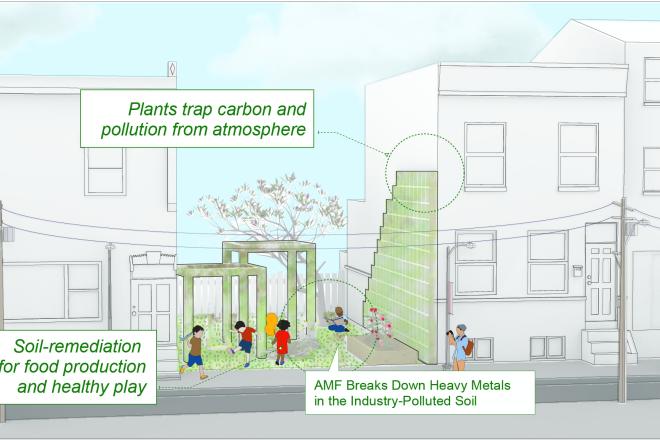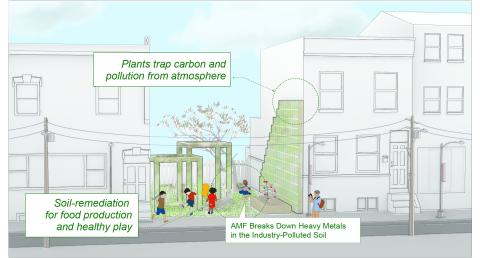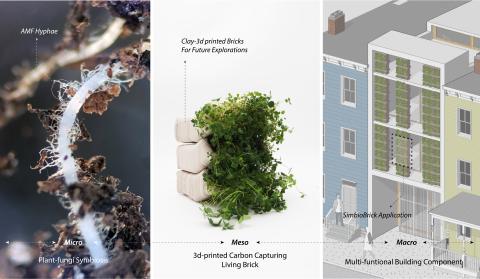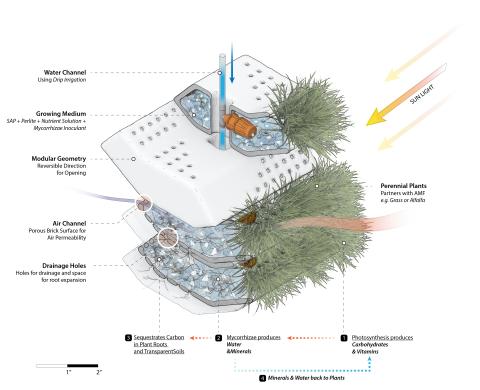Fungi on the front lines against environmental injustice
Picture former industrial sites reborn as vibrant community gardens, offering safe, green spaces for children to play, free from heavy metal contamination. Thanks to the collective efforts of the Symbiotic Architecture for Environmental Justice research community, this vision is closer to becoming a reality.

By Xime Trujillo
Picture former industrial sites reborn as vibrant community gardens, teeming with fresh produce and offering safe, green spaces for children to play, free from the specter of heavy metal contamination. This vision, though seemingly idyllic, is rapidly taking shape thanks to the tireless efforts of the Symbiotic Architecture for Environmental Justice research community.
Inspired by nature, Laia Mogas-Soldevila, assistant professor of graduate architecture at Penn’s Weitzman School of Design and director of DumoLab, leads a multidisciplinary collaboration that includes architects, designers, biologists, mycologists, and toxicologists. Their collective goal is to develop a living structure capable of sequestering carbon and remediating contaminated soil. At the heart of their endeavor lies a fundamental ecological process: nutrient cycling by fungi. The fungi in question, known as mycelium, live in symbiosis with plants, residing in their roots, where they decompose nutrients in the soil that are essential for plant growth.

Letting the fungi live
In the realm of architecture and design, fungi have garnered attention due to their network-like root patterns called mycelium and “tunable" properties during growth. Composed of tiny filaments called hyphae, mycelium connects to form large threads that branch out through the soil, creating extensive interconnected systems.
“Imagine mycelium as a network that grows while digesting organic matter,” explains Mogas-Soldevila.
This unique characteristic allows mycelium fungi to play a pivotal role in the development of materials that interact with biological systems. In most current applications, mycelium materials are baked, killing the fungi after its network has digested provided organic matter within a mold to make bricks or panels. But Ji Yoon Bae, the Ph.D. student at DumoLab leading the project asks: what if the fungi remained alive? The mycelial threads – if in contact with the ground - could continually enhance nutrient cycling and cleanse soil of heavy metals through a process known as bioremediation. This opens the possibility of constructing multifunctional structures with inherent bioremediation capabilities.

Creating a support system
To put this idea to the test, the designers at DumoLab aimed to construct a living bioremediation structure enlightened by the work of Vasilis Kokkoris, assistant professor at the Amsterdam Institute for Life and Environment at Vrije Universiteit Amsterdam. The Kokkoris Lab studies the potential of Arbuscular Mycorrhizal Fungi (AMF) to secure a sustainable future for human agriculture at the petri dish scale. Next, the DumoLab team delved into optimizing a habitable brick geometry that enhances parameters, such as irrigation and sunlight exposure, to develop a support system that would enable AMF and their plant hosts, alfalfa, to flourish. A partnership between Mogas-Soldevila and the laboratory of Corlett Wood, an assistant professor in the School of Arts & Sciences’ Department of Biology, worked to elucidate the association between AMF and alfalfa. Through these and other collaborative efforts, the research community has successfully constructed a multifunctional support system that facilitates nutrient cycling by AMF while safeguarding the fungi’s symbiotic relationship with alfalfa, offering a promising, scalable solution for sustainable environmental remediation.
The multifunctional structures are constructed using 3D-printed clay bricks, in which AMF and alfalfa thrive. With a porous design, the “habitable bricks” or living bricks have unique water retention capabilities, facilitating the expansion and interconnection of AMF networks. Initial evidence suggests the bricks may have significant potential for carbon capture through the photosynthesis of alfalfa. Moreover, the bricks’ interlocking geometry enables self-support without additional materials, rendering them highly versatile for constructing walls or pathways.
“Scaling a living system using a plug-and-play component is exciting for biologists and mycologists because they are curious about how their findings perform at scale,” Mogas-Soldevila emphasizes.
DumoLab researchers are set to present the work at the Design Modeling Symposium (DMS) in Kassel, Germany next fall and have a publication underway. The theme of the conference is “Scalable Disruptors,” discussing (re)new(able) materials, circular design and construction processes, and the article will be presented in the Biomaterial Design track. “We have been able to advance this far with our living structure because we are a community,” says Mogas-Soldevila. “That is why all this is working.”

The next phase of implementation involves evaluating the innovation’s potential for bioremediation in a controlled setting. Subsequently, the collective expertise of the research community will join efforts to conduct test-bed studies in Fishtown, a neighborhood in Philadelphia home to many former lead smelters. Field studies conducted in 2017 by Reto Gieré, professor of earth and environmental science, found evidence in-situ of heavily polluted soils with lead.
Despite the daunting nature of environmental and climate justice challenges, “in every project we approach climate and environmental justice with a positive attitude to distance our perspective from eco-phobia and towards a mindset of possible change,” says Mogas-Soldevila. Beyond symbiotic architectures, these living structures not only expand current understanding of mycelium communities and their applications, but also hold the potential to revitalize neighborhoods burdened by industrial pollution, fostering healthier and greener environments for all.
“...in every project we approach climate and environmental justice with a positive attitude to distance our perspective from eco-phobia and towards a mindset of possible change” -Laia Mogas-Soldevila, Assistant Professor at Weitzman School of Design and Director of DumoLab